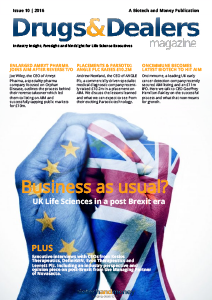Graham also presents his further non-clinical achievements of the last 12 month after IPO and his highly strategic management and executive board.
Graham Lumsden is responsible for all aspects of the strategy, management, and operations of the Company. Mr. Lumsden has a proven record of success leading change and delivering results in subsidiary and global leadership positions. Prior to this he was a senior executive at Merck & Co., Inc. where he held several commercial leadership
B&M: What does Motif Bio do and what sets you apart in the drug
development market?
GL: Motif Bio is all about developing antibiotics, specifically ones that target multi-drug resistant bacteria (the so-called “superbugs).
What’s unique about Motif is that we are particularly focused on the hospital segment. That’s really where the greatest unmet need is, where we have patients with various infections, who are running out of antibiotic options.
Furthermore, governments have started to recognise this problem. Sally Davis, the Chief Medical Officer in England has written a whole book about the threat of antibiotic resistance. Routine procedures like hip replacements become very risky without effective antibiotic coverage. Cancer patients on chemotherapy are another example of a group who are dependent on antibiotics. Thus, we are seeing government initiatives, such as in the GAIN Act in the United States, which incentivises antibiotic development.
So we think Motif is in the right place at the right time.
Our lead programme is an antibiotic called iclaprim, which has been granted “qualified infectious disease product” (QIDP) status, resulting in ten years of market exclusivity in the US if approved, fast track status and accelerated review of the NDA (new drug application).
B&M: Fantastic. Being in the right place at the right time gives you a very strong USP. Can you outline the major milestones Iclaprim has achieved over the last 12 months?
GL: Iclaprim is an interesting opportunity from an investor’s perspective. We’re entering phase 3, the last stage in clinical testing for novel pharmaceuticals, and iclaprim has already been used to successfully treat over 500 patients, which is unusual for a drug just entering phase 3. Thus, we already have a database of safety and efficacy.
Iclaprim works in a very different way to almost every other antibiotic. It is a dihydrofolate reductase inhibitor. Other antibiotics in the market are either tetracyclines, glycopeptides or aminoglycosides. Iclaprim works via a different mechanism to these and thus it can maintain efficacy in bacteria that have developed resistance to other mechanisms. I addition, it’s been shown in laboratory conditions to have a very low propensity for resistance development, making it ideal for use as an empiric (first line) treatment.
We secured the worldwide exclusive development to commercialisation rights to Iclaprim as a result of our AIM listing on the 2nd of April 2015. Since then, we were granted QIDP designation by the FDA. We also have an agreement with the MEB, the Medicines Evaluation Board, which is the regulatory authority in the Netherlands. So both the FDA and MEB have agreed with the specifics of our trial protocol and dose of iclaprim we’re going to use. This means that we already have established agreements from the regulatory authorities on both sides of the Atlantic
The next milestone was confirmation of availability of the clinical trial supplies needed to enter phase 3, which requires a significant increase in number of trial participants compared to phase 2. Traditionally, the technological feasibility of scaling up the commercial side can be difficult and expensive for novel pharmaceuticals. In our case, we acquired iclaprim in April and acquired all the data from the previous development work, as well as a huge quantity of API (active pharmaceutical ingredient) that we can use to manufacture clinical trial supplies. This is important for investors because we’ve been able to de-risk the technological feasibility of being able to manufacture commercial scale batches.
So these are the major milestones- QIDP status, agreements with FDA and MEB, and manufacturing the clinical trial supplies.
B&M: What is Motif Bio’s longer term development strategy?
GL: We model ourselves around a company called Cubist, one of the most successful dedicated antibiotic company in recent years. Cubist was acquired by Merck and Co., Inc. for about 9.5 billion dollars at the beginning of 2015. Their lead compound, daptomycin, started off as we are with iclaprim. They built a pipeline of novel antibiotics behind daptomycin, and that’s exactly what we’re intending to do after iclaprim. The predictions for the global antibiotic market is estimated at around 26 billion dollars in 2015. That is forecasted to grow to over 40 billion dollars in 2020. We are already engaged in some interesting discussions with universities and companies that have novel antibiotics targeting both gram positive and gram negative bacteria with a view to potential licensing agreements.
B&M: Can you tell us more about these partnerships?
GL: Yes. We can either licence the right to develop novel antibiotics and do the work ourselves, or we can work together with companies, universities, and other teams of scientists already in place, supporting them financially and determining if economic returns make it viable to develop the drug to market. Within Motif, we have great scientific and clinical expertise, which allows us to decide which route we would take in any given case.
B&M: In the 12 months since your very successful IPO last year, you have brought together a highly strategic management and executive board. What are some of the non-clinical achievements you’re most proud of?
GL: The most important achievement was developing a platform to
approach the institutional investor base in London since we came to market in April. We were able to announce the follow-on raise in July where we raised £22 million gross, and the three declared investors who participated were Aviva, Invesco and Standard Life. It was crucial for Motif to have a solid base of institutional investors.
The other achievement was building a team of top talent in the organisation. We have focussed on the key people we need to support iclaprim, as well as develop our pipeline. Dr David Huang coming in as CMO was a really important step for us. In addition to that we have Dr Bob McCormack, who was formerly head of regulatory at Cubist. Not only is he an expert regulatory scientist, he has considerable experience with the FDA.
We also have Dr Richard Peck who is based just outside Basel in Switzerland, our regulatory for Europe. Richard was actually formerly head of regulatory for Arpida, which was the company that previously developed iclaprim. Thus he has a lot of institutional knowledge from his prior work.
Finally, we have Dr Mark Van Arendonk. Mark is a pharmaceutical
sciences and CMC (chemistry, manufacturing & controls) expert. He was really at the forefront of being able to get our clinical trial supplies manufactured. The right team has meant that iclaprim is on track to complete phase 3 trials in 2017, and we will be ready for an FDA decision by 2018.
B&M: Obviously you have started with the end in mind. What else have you learnt from the process of IPO and revisiting investors for follow-on funding? Public market investors are obviously a very different breed to private financing.
GL: You have to consider the two groups of investors in the UK. We have talked about the institutional investors. There are also retail investors.
Retail investors are often not necessarily specifically focussed on
pharma biotech, but they may have heard of antibiotics due to media coverage of the looming antibiotic crisis. It is really important for retail investors to be continuously updated on goals, accomplishments and milestones
B&M: Obviously as a company that has operations in North America and the UK, and also being listed on AIM, is the next logical step for the company to do a dual listing on NASDAQ as part of your future growth strategy?
GL: There is a huge pool of capital in the US. There are also many
more pharma biotech investors in the US than in the UK.
If you look at all our comparable companies, those companies would include Cempra, Nabriva, Paratek, Tetraphase. All these companies are listed on NASDAQ. So what we’ve done is identified and partnered with a specialist investor relationship group, Westwicke Partners, to help inform us on proceeding in the US. We’ve also partnered with an investment bank called MTS Partners. MTS has a tremendous network of connections with the US buy side investors that invest in pharma biotech companies. We have also contracted one of the top four accounting firms, PWC, as our accountants and auditors. Announcing these developments give clear signals to investors. If we receive an enthusiastic response in the US, we can certainly think about moving towards a NASDAQ listing. Having said that, the markets have been in decline for the last few months for all sorts of global
macroeconomic reasons. As a public listed company, it’s very important for us to look at other options above and beyond equity
capital markets in order to continue funding Motif.
We announced a couple of weeks ago that we’ve made good progress in finding potential strategic partners. Being focused on the hospital segment, we can commercialise in the US with a relatively small contracted sales and marketing team focused on hospital infectious disease specialists. If we were targeting community infections, we would need a much larger sales footprint to cover General Practitioners and Primary Care Practitioners – a more diverse pool of prescribing physicians.
We are then going to identify other pharmaceutical companies with sales and marketing organisations in Europe, Japan, India and Latin America. We can then partner with these companies and they can commercialise Iclaprim on our behalf. The deal will consist of an up-front payment together with milestones and royalties. Up-front payments would bring in some capital, of course, and we are aiming to announce one or more partners in
2016.
B&M: If markets are right, progress is right and strategic partnerships pay off for yourself and Motif, what is the level of ambition you hold for the company?
GL: The markers for us are comparable companies currently listed
on NASDAQ. Let me give you some examples.
Paratek also have an antibiotic and they are a little bit ahead of us in phase 3 development. They’re currently listed on NASDAQ and the market has been awful but they have been very close to $300 million as market capitalisation.
The second one is called Cempra. Cempra is basically where we hope to be in the second half of 2017, so they’re about 18 months ahead of us. They’ve completed phase 3 trials with their first new antibiotic. Even with market turmoil their market capitalisation is around $800 million.
B&M: You have mentioned the market potential for antibiotics, including governments recognising the unmet need, combined with companies developing similar products that are being well received in the US. Are these factors what excites you about the potential of the sector?
GL: There are more expert pharma biotech investors in the US than in the UK. It’s not a criticism, just a reality. It is definitely right for our current investor base that we explore the pool of capital available in the US, which is so much larger than anywhere else.
We talked about being in the right place at the right time. We talked about the market growing from 20 billion to 40 billion. One of the reasons why the market is forecasted to grow substantially over the next 5 years is the pricing of antibiotics. The single most important reason we’re faced with this apocalyptic threat, as some experts are calling it, in multidrug resistant bacteria, is that the price of antibiotics is too low. It has not been commercially attractive for large pharma companies to dedicate research and development investment to antibiotics. It’s more attractive to focus on some of the more chronic care therapeutic areas like type 2 diabetes, oncology, hypertension, etcetera.
The price point for hospital antibiotics in the US has been approximately 350 dollars a day for a number of years now. So if you imagine on average a ten-day course of therapy is $3,500 per patient. The outcome is hopefully you save the patient’s life, because we’re talking about life threatening infections here. 3,500
sounds like very good value to mefor saving a patient’s life, particularly when new cancer products cost several hundred thousand per patient to prolong life for just a few months.
Things might be changing though. A new antibiotic was launched in the US market last year. It is not yet available in Europe. Priced at $1000 per day of treatment, it has been well accepted in the marketplace.
Jim O’Neill’s Antimicrobial Resistance Review Committee in the UK is looking at pricing incentives for companies like ourselves. And there are initiatives in the US addressing pricing incentives in the US marketplace. We’re starting to see some better price points in the market place for antibiotics.
B&M: So it seems purchasers and governments have realised they have to be willing to pay the price for new antibiotics, to update their arsenal of antibiotic resistant drugs. What you’re developing can benefit many patients, and save lives.
GL: It’s near and dear to our heart as an antibiotic company. Unfortunately, the media bandwagon promotes the wrong message that pharmaceutical pricing is out of control. With antibiotic development, quite the reverse is true. Antibiotic pricing has been too low, and now we are facing a crisis.
B&M: So Graham, I always like asking this closing question. You have had 12 months’ experience now as a CEO of a publicly listed company. What are the key lessons?
GL: The most important thing is the glass half full approach. You’re faced with adversity on a regular basis, and it’s very important as a leader of an organisation like Motif that the team is able to deal with challenges and keep focused on the goal. When problems come up we deal with them and get back on track quickly.
I have also made sure I surround myself with top talent. In addition to the leadership team, we have selected a good team of advisors. Brokers in London, legal support and financial support were all chosen after much diligence.
B&M: I think we will close the interview here. Do you have any final comments?
GL: In the UK there is so much media coverage of the antibiotic crisis, but few people are aware of AIM listed companies developing potential solutions. Yes, antibiotic resistance is an apocalyptic threat. But companies like Motif Bio are here, working on it.
Graham Lumsden is responsible for all aspects of the
strategy, management, and operations of the Company. Mr. Lumsden has a proven record of success leading change and delivering results in subsidiary and global leadership positions. Prior to this he was a senior executive at Merck & Co., Inc. where he held several commercial leadership
Motif Bio is a clinical stage biopharmaceutical company which specializes in developing novel antibiotics designed to be effective against serious and life-threatening infections caused by multi-drug resistant bacteria. Iclaprim is being developed for the treatment of the most common and serious bacterial infections
such as acute bacterial skin and skin structure infections (ABSSSI) and hospital acquired bacterial pneumonia (HABP).

















Add Your Response